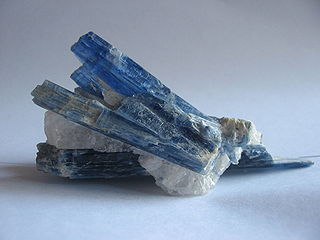
Kyanite is a typically blue aluminosilicate mineral, found in aluminium-rich metamorphic pegmatites and sedimentary rock. It is the high pressure polymorph of andalusite and sillimanite, and the presence of kyanite in metamorphic rocks generally indicates metamorphism deep in the Earth's crust. Kyanite is also known as disthene or cyanite.
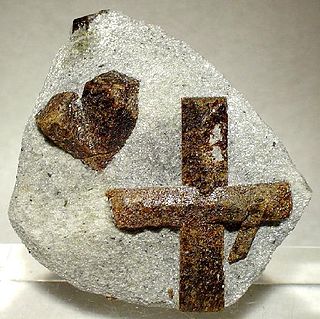
Staurolite is a reddish brown to black, mostly opaque, nesosilicate mineral with a white streak. It crystallizes in the monoclinic crystal system, has a Mohs hardness of 7 to 7.5 and the chemical formula: Fe2+2Al9O6(SiO4)4(O,OH)2. Magnesium, zinc and manganese substitute in the iron site and trivalent iron can substitute for aluminium.

Epidote is a calcium aluminium iron sorosilicate mineral.

Enstatite is a mineral; the magnesium endmember of the pyroxene silicate mineral series enstatite (MgSiO3) – ferrosilite (FeSiO3). The magnesium rich members of the solid solution series are common rock-forming minerals found in igneous and metamorphic rocks. The intermediate composition, (Mg,Fe)SiO
3, has historically been known as hypersthene, although this name has been formally abandoned and replaced by orthopyroxene. When determined petrographically or chemically the composition is given as relative proportions of enstatite (En) and ferrosilite (Fs) (e.g., En80Fs20).
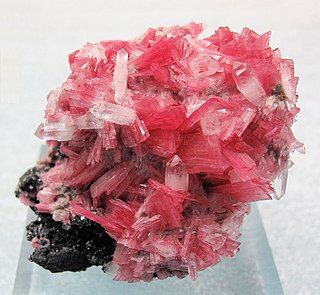
Rhodonite is a manganese inosilicate, (Mn, Fe, Mg, Ca)SiO3 and member of the pyroxenoid group of minerals, crystallizing in the triclinic system. It commonly occurs as cleavable to compact masses with a rose-red color (the name comes from the Greek ῥόδος rhodos, rosy), often tending to brown because of surface oxidation. The rose-red coloring is caused by manganese(2+).

The chlorites are the group of phyllosilicate minerals common in low-grade metamorphic rocks and in altered igneous rocks. Greenschist, formed by metamorphism of basalt or other low-silica volcanic rock, typically contains significant amounts of chlorite.

Fayalite is the iron-rich end-member of the olivine solid-solution series. In common with all minerals in the olivine group, fayalite crystallizes in the orthorhombic system with cell parameters a 4.82 Å, b 10.48 Å and c 6.09 Å.
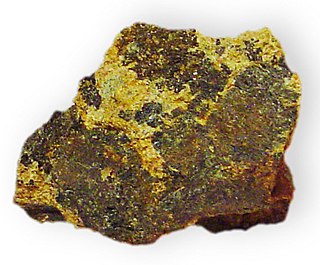
Cummingtonite is a metamorphic amphibole with the chemical composition (Mg,Fe2+
)
2(Mg,Fe2+
)
5Si
8O
22(OH)
2, magnesium iron silicate hydroxide.

Allanite (also called orthite) is a sorosilicate group of minerals within the broader epidote group that contain a significant amount of rare-earth elements. The mineral occurs mainly in metamorphosed clay-rich sediments and felsic igneous rocks. It has the general formula A2M3Si3O12[OH], where the A sites can contain large cations such as Ca2+, Sr2+, and rare-earth elements, and the M sites admit Al3+, Fe3+, Mn3+, Fe2+, or Mg2+ among others. However, a large amount of additional elements, including Th, U, Be, Zr, P, Ba, Cr and others may be present in the mineral. The International Mineralogical Association lists four minerals in the allanite group, each recognized as a unique mineral: allanite-(Ce), allanite-(La), allanite-(Nd), and allanite-(Y), depending on the dominant rare earth present: cerium, lanthanum, neodymium or yttrium.
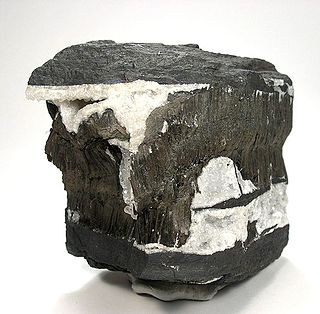
Todorokite is a rare complex hydrous manganese oxide mineral with the chemical formula (Na,Ca,K,Ba,Sr)
1-x(Mn,Mg,Al)
6O
12·3-4H
2O. It was named in 1934 for the type locality, the Todoroki mine, Hokkaido, Japan. It belongs to the prismatic class 2/m of the monoclinic crystal system, but the angle β between the a and c axes is close to 90°, making it seem orthorhombic. It is a brown to black mineral which occurs in massive or tuberose forms. It is quite soft with a Mohs hardness of 1.5, and a specific gravity of 3.49 - 3.82. It is a component of deep ocean basin manganese nodules.

Clinozoisite is a complex calcium aluminium sorosilicate mineral with formula: Ca2Al3(Si2O7)(SiO4)O(OH). It forms a continuous solid solution series with epidote by substitution of iron(III) in the aluminium (m3 site) and is also called aluminium epidote.

Chloritoid is a silicate mineral of metamorphic origin. It is an iron magnesium manganese alumino-silicate hydroxide with formula (Fe, Mg, Mn)
2Al
4Si
2O
10(OH)
4. It occurs as greenish grey to black platy micaceous crystals and foliated masses. Its Mohs hardness is 6.5, unusually high for a platy mineral, and it has a specific gravity of 3.52 to 3.57. It typically occurs in phyllites, schists and marbles.

Lawsonite is a hydrous calcium aluminium sorosilicate mineral with formula CaAl2Si2O7(OH)2·H2O. Lawsonite crystallizes in the orthorhombic system in prismatic, often tabular crystals. Crystal twinning is common. It forms transparent to translucent colorless, white, and bluish to pinkish grey glassy to greasy crystals. Refractive indices are nα=1.665, nβ=1.672 - 1.676, and nγ=1.684 - 1.686. It is typically almost colorless in thin section, but some lawsonite is pleochroic from colorless to pale yellow to pale blue, depending on orientation. The mineral has a Mohs hardness of 8 and a specific gravity of 3.09. It has perfect cleavage in two directions and a brittle fracture.
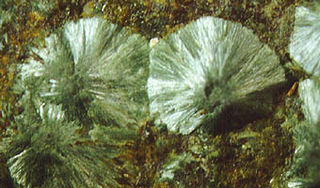
Pumpellyite is a group of closely related sorosilicate minerals:

Fluorapatite, often with the alternate spelling of fluoroapatite, is a phosphate mineral with the formula Ca5(PO4)3F (calcium fluorophosphate). Fluorapatite is a hard crystalline solid. Although samples can have various color (green, brown, blue, yellow, violet, or colorless), the pure mineral is colorless, as expected for a material lacking transition metals. Along with hydroxylapatite, it can be a component of tooth enamel, but for industrial use both minerals are mined in the form of phosphate rock, whose usual mineral composition is primarily fluorapatite but often with significant amounts of the other.

Dollaseite-(Ce) is a sorosilicate end-member epidote rare-earth mineral which was discovered by Per Geijer (1927) in the Ostanmossa mine, Norberg district, Sweden. Dollaseite-(Ce), although not very well known, is part of a broad epidote group of minerals which are primarily silicates, the most abundant type of minerals on earth. Dollaseite-(Ce) forms as dark-brown subhedral crystals primarily in Swedish mines. With the ideal chemical formula, CaREE3+
Mg
2AlSi
3O
11,(OH)F, dollaseite-(Ce) can be partially identified by its content of the rare earth element cerium.

Kanoite is a light pinkish brown silicate mineral that is found in metamorphic rocks. It is an inosilicate and has a chemical formula of (Mg,Mn2+)2Si2O6. It is a member of pyroxene group and clinopyroxene subgroup.

Serandite is a mineral with formula Na(Mn2+,Ca)2Si3O8(OH). The mineral was discovered in Guinea in 1931 and named for J. M. Sérand. Serandite is generally red, brown, black or colorless. The correct name lacks an accent.
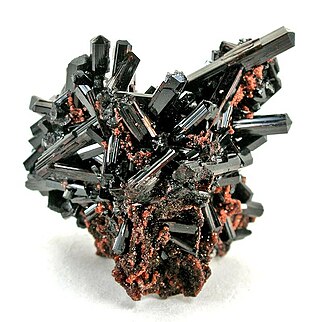
Manganvesuvianite is a rare mineral with formula Ca19Mn3+(Al,Mn3+,Fe3+)10(Mg,Mn2+)2(Si2O7)4(SiO4)10O(OH)9. The mineral is red to nearly black in color. Discovered in South Africa and described in 2002, it was so named for the prevalence of manganese in its composition and its relation to vesuvianite.

Inesite is a hydrous calcium manganese silicate mineral. Its chemical formula is Ca2Mn7Si10O28(OH)2•5(H2O). Inesite is an inosilicate with a triclinic crystal system. It has a Mohs hardness of 5.5 to 6, and a specific gravity of 3.0. Its name originates from the Greek Ίνες (ines), "fibers" in allusion to its color and habit.





















